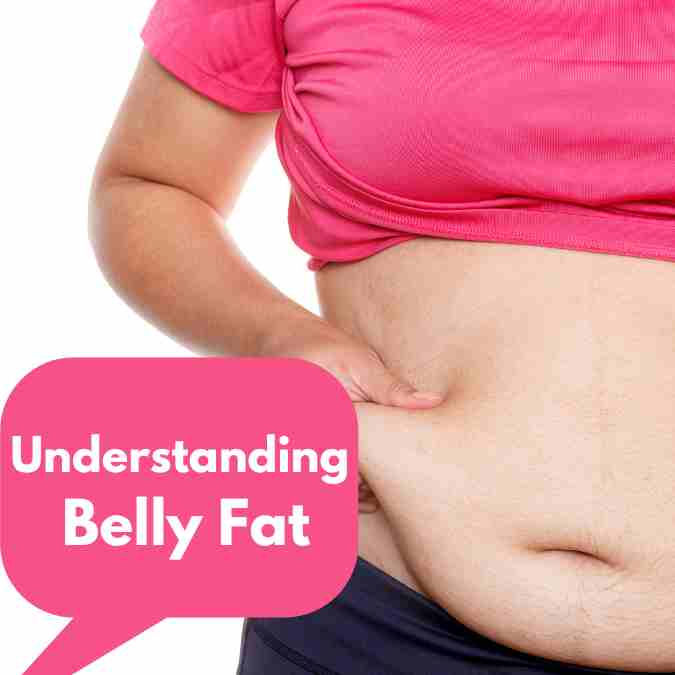Whether your in your 30’s 40’s, 50’s or beyond, belly fat matters.
Did you know, that 2022 – 2023 stats show that 64% of UK adults were estimated to be overweight or obese. This includes around 28% classed as obese (BMI of 30+).
With studies showing that millennials are gaining weight faster compared with generation X women, these numbers are only set to increase.
Obesity is more prevalent in women than men, particularly during midlife, when reproductive and physiological aging coincide, changing body composition.
In fact, obese post menopause women have a 4-fold increased risk of cardio vascular mortality.
The risk of postmenopausal breast cancer increases by 11% for every 5 kg gained as an adult.
Obesity is also the strongest risk factor for endometrial cancer, with every 5 kg/m2 increment in BMI associated with a 60% increase in risk .
Whether this increase in obesity is a consequence of menopause, age, genetics, and/or environmental factors is a subject of ongoing debate.
What we do know, is that during this time multiple factors contribute to the increase of body weight, belly fat and fat and a decrease in lean mass (muscle) that result in a change of body composition.
The Perfect Weight Gain Storm
Hormonal changes, poor nutritional intake and physical inactivity, all of which synergistically promote weight gain and belly fat.
Basal metabolic rate (how your body uses most of your energy/calories on a daily basis) is also reducing due to the aging process, along with muscle mass loss, and the reduction in brown tissue activity.
The decrease in muscle mass is accompanied by a progressive increase in fat mass, changes in body composition, and increased insulin resistance which in turn promotes weight gain.
There’s a lot happening – but that said, there are factors within our control.
Whilst weight gain has not been classified as a menopause symptom as such, the increase in body fat accumulation and shift of fat to the abdomen region with belly fat is the result of menopause–driven pathways.
To recognizing either aging, or menopause as the sole route of these changes is an over-simplification, as there are several factors that contribute to the changes in body composition, which happen in a synergistical manner.
What is happening is a perfect weight gain storm.
Menopause Weight Gain
The hormonal changes during the menopause transition alter body composition dynamics, which in turn, induce a reduction in basal metabolic rate and bring with it an increase in appetite stimulating hormones.
Combined this with further age-related decreases in basal metabolic rate, inflammation, physical inactivity, gut dysbiosis (gut microbiome imbalance) and sleep disturbances all lead to a perfect storm for weight gain.
So what does these changes lead to…
Evidence suggests that obesity during the menopausal transition causes metabolism complications, oncologic disease, mental health disturbances and menopausal symptoms
Impairments of the circadian system are associated with reduced melatonin secretion, altered sleep–wake cycles and metabolic inflexibility.
Given that women may spend 30–40% of their lives in a post-menopause state, achieving a healthy body weight becomes crucial.
Menopause is a retrospective diagnosis made 12 months after the permanent cessation of menstruation.
The current average age of menopause is 51 years.
The menopause transition is a progressive transition, from the late reproductive years, through the perimenopause, to the final menstrual period and the early and late menopause, characterized by menstrual irregularity, vasomotor symptoms (VMS), sleep disturbances, and the genito-urinary symptoms, as well as increased risks of cardiovascular (CVS) disease, metabolic syndrome (MetS), osteoporosis, and several malignancies.
The physiologic and metabolic changes associated with the menopause are a direct effect of estrogen deficiency, which has been shown to affect lipid (fat) metabolism, energy consumption, insulin resistance.
Body fat composition changes also occur, with increased cardiometabolic and metabolic risks.
Body shape can shift from pear shape (hips & thigh fat) to more apple or android body shape with increase in both belly fat (subcutaneous fat) and visceral fat (internal fat) accumulation.
Measuring Belly Fat: Waist to Hip Ratio
The complex interaction between age, obesity, and menopause is the subject of several ongoing studies.
Current evidence from studies, such as the Study of Women’s Health Across the Nation (SWAN) and the Women’s Health Initiative (WHI), suggests that the perimenopausal increase in obesity, measured by body mass index (BMI), is a consequence of age.
Menopause is, however, associated with an increase in truncal obesity (around the abdomen) and visceral adiposity (measured by waist circumference and waist-to-hip ratio), which are more associated with increased cardiovascular risk, metabolic syndrome, and hormone-related malignancies like endometrial and breast cancers.
It has been suggested that either the BMI threshold for health screening should be lowered in menopause women or that other measures that are more indicative of abdominal and visceral adiposity, such as waist-to-hip ratio, and newer anthropometric indexes, such as a body shape index, should be used.
How To Measure Waist to Hip Ratio
Find the bottom of the ribs and the top of the hips.
Wrap a tape measure around the waist midway between these points (this will be just above the belly button), and breathe out naturally before taking the measurement.
How To Calculate Waist to Hip Ratio
Measure waist circumference and height in the same units (either both in centimetres or both in inches). If you know your height in feet and inches, convert it to inches (for example, 5 feet 7 inches is 67 inches).
Divide waist measurement by height measurement. For example:
- 38 inches divided by 67 inches = waist-to-height ratio of 0.57 or
- 96.5 cm divided by 170 cm = waist-to-height ratio of 0.57.
- Use BMI as a practical measure of overweight and obesity. Interpret it with caution because it is not a direct measure of central adiposity.
Your results show:
- healthy central adiposity: waist-to-height ratio 0.4 to 0.49, indicating no increased health risks
- increased central adiposity: waist-to-height ratio 0.5 to 0.59, indicating increased health risks
- high central adiposity: waist-to-height ratio 0.6 or more, indicating further increased health risks.
These classifications can be used for people with a BMI under 35 kg/m2 of both sexes and all ethnicities, including adults with high muscle mass.
- The larger your waist, the higher your waist to height ratio.
- A ratio over 0.5 to 0.59 suggests that you have excess fat around your belly. This means you have an increased risk of health problems which include type 2 diabetes, hypertension and cardiovascular disease.
- And if your ratio is 0.6 or above, your risk is even higher.
When measuring belly fat, a good way of remembering is to keep the waist to half the height (so a waist-to-height ratio of under 0.5).
Obesity, Belly Fat and Menopausal Transition
Your bodyweight can affect both the age you enter the menopause transition and also impact the severity of menopause symptoms.
Several factors have been suggested to affect the age of natural menopause; there is, for example, evidence for an association between genetics and smoking and younger age of onset of menopause.
The average menopause age has progressively increased, which is most likely because of a combination of factors, including genetic and environmental, especially that there remains a variance in the age at menopause from one country/region to another: for example, 49 years in Korea and Iran, 51 years in the United Kingdom, and 52 years in the United States and Australia.
Most studies associate obesity with a later onset of menopause.
Obesity, Bell Fat and Menopause Symptoms
Several studies have shown that perimenopause women with obesity experience more severe vasomotor symptoms than women of normal weight.
Vasomotor symptoms are an important and common menopause symptom, hot flushes, are a sudden sensation of heat, usually starting from the face or chest, spreading through the body, and lasting 1–5 min.
This, together with night sweats, make up the vasomotor symptoms experienced by 50–80% of perimenopausal women, causing sleep disturbances, irritability, and poor quality of life.
Obesity, particularly that associated with an increased abdominal girth, has also been linked to sleep apnea and other sleep disturbances in menopausal women, as have genito-urinary symptoms.
Menopause weight gain has also been explained by the effect of estrogen deficiency on energy intake and expenditure.
Estrogen has been shown to have an inhibitory effect on appetite, and the depletion of estrogen postmenopause is thought to centrally control energy intake and energy expenditure.
Management of menopause and related obesity
Hormone Replacement Therapy
Evidence shows that Hormone replacement therapy (HRT), is the most effective treatment for menopausal symptoms.
Current evidence supports its use in young, healthy menopausal women younger than 60 years and within 10 years of menopause, with benefits typically outweighing risks.
Perimenopausal women with obesity are more likely to be symptomatic and thus may require HRT.
HRT, however, is associated with increased risks of venous thromboembolism, cardiovascular complications, and breast and endometrial cancers, especially in women with obesity; as such, there should be a careful risk-benefit assessment in obese women requiring HRT.
Estrogen replacement has been shown in both animal and human studies to reverse the estrogen depletion associated with weight gain and body fat redistribution.
Several studies have shown a beneficial effect of hormone therapy in the reduction of central adiposity and preservation of lean body mass.
However, current advice, is not to use HRT to prevent or treat menopause-associated weight gain and visceral fat because the risks outweigh the benefits.
Lifestyle changes and exercise
There is clear evidence that lifestyle changes, such as regular physical activity and dietary management, have a positive effect on health and prevention of chronic diseases.
In addition, intensive lifestyle changes leading to weight loss have been shown to reduce hot flushes.
A 5-year intervention study of pre-menopausal women aged 44–50 years showed the beneficial impact of lifestyle changes on body composition in middle-aged women.
The lifestyle intervention program included sessions on diet, cooking, and physical activity, as well as support and motivation to ensure adherence to the program.
After 4.5 years, 55% of those in the intervention group were at or below baseline weight, whereas only 26% of the control group maintained or lost weight.
Maintained weight loss also correlated with improvements in LDL-C level, triglyceride level, and systolic blood pressure.
This study showed that lifestyle intervention and education programs may prevent adverse changes in body composition during the peri-to postmenopausal period.
Age-related declines in resting energy expenditure are not seen among women who exercise regularly.
A recently published meta-analysis of walking intervention studies among perimenopause and postmenopausal women showed statistically significant improvements in BMI, body weight, and body fat percentage compared with the no-exercise groups.
For more support, check out Pretty Pea Meno Weight supplements.

References
Obesity and menopause study 2023 science direct doi.org/10.1016/j.bpobgyn.2023.102348
Obesity Profile: short statistical commentary May 2024 – GOV.UK (www.gov.uk)
Recommendations | Obesity: identification, assessment and management | Guidance | NICE

